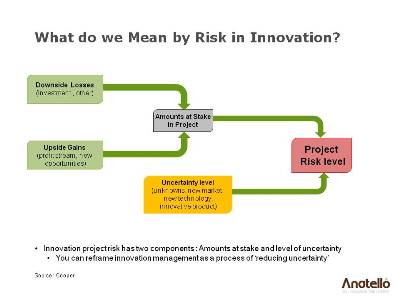Anatellô
Monthly Archive
How to Manage Risk to Get Bigger Innovation Rewards. Part II
Part 1 of this topic discussed how research* has shown that 85-90% of innovation portfolios are made up of low risk projects. As there's a strong correlation between risk and reward, it is likely therefore that most companies are not maximising the return on their innovation investment.
This may be because the leadership team and the organisational culture are risk-averse.
In part 2, we explain more about the nature of risk in innovation and suggest more ways to manage it. When teams are confident at managing risk in innovation, they can get greater rewards on their innovation efforts by including some riskier projects in their portfolio.
What is Risk in Innovation?

Cooper's innovation risk model shows us that innovation project risk has two components,
- The amounts at stake
- The level of uncertainty.
With this in mind we can reframe innovation management as a process of ‘reducing uncertainty’.
This in turn, can help us make better investment decisions. In particular, teams need to be clear that every time they invest in the innovation project ( be it in market research, testing technology or anything else). That investment should reduce uncertainty. That is what the investment is all about – buying information to reduce uncertainty.
Quite simply if you are asked to approve further funds for an innovation project and after the investment you will not have reduced uncertainty; e.g, have a more tightly defined target market, or have a tighter spec for a new technology, then that will not be a good investment.
The Innovation Conundrum.
Research shows that one key critical success factor for innovation is : developing a superior product that is strongly differentiated. Herein lies the challenge with risk. Differentiation means that the product or service has new aspects to it – technology or function. This means it’s never been done before . Therefore pursing a ‘differentiated product’ is by definition risky. It is more risky than say a proposition or technology that has already been brought to market by a competitor.
This is where many organisations step back from their proposed innovation. Instead of taking forward the highly differentiated product – (that could lead to significant innovation success) they retreat and opt to go with the known technology or the ‘me too’ proposition. This approach of course has less chance of resulting in a differentiated product – and therefore has less chance of success.
Instead, what’s needed, is to continue to pursue the differentiated propositions – but in a way that manages the risk i.e. ensuring that when investments are approved that they will reduce uncertainty.
3 Tips for Managing Risk in Innovation.
In part 1 we looked at how portfolio management and project selection can help manage risk. Below are three more tips that can be used to help manage risk in innovation.
1. Stage-gate Process
A good stage-gate process can make a significant contribution to managing risk in innovation. Sometimes teams get poor results with a stage gate process. However, in such cases it may be that the team is not using a stage-gate process to its best effect.
To get excellent results with a stage-gate process you need to take a 'quality management' approach.. You need to do the work for each particular stage 'right first time’ and ‘on time’ . You need to do adequate upfront work to explore the markets and the technologies.
2. Excellent Governance.
Within your stage-gate process you need to have ‘gates with teeth’. This means that the gate process has to actually weed some projects out. Also, It is important that when a project goes through the gate, then resources are allocated at the same time.
A major problem with stage-gate can be that more projects are approved than there are resources for. If you do not allocate adequate resources to a project then you are increasing the risk of failure for that project – and possibly the other ones in the portfolio as their resources are filched for the new project
3. Learning from Failure
Another key aspect of reducing risk is to learn from failure. A 'post project review' should be conducted for all innovation projects. However, where a project does not get to market there may be even more learnings. If these are documented then they will increase the knowledge of the team and more broadly within the organisation. These aspects can also help reduce risk further in the future.
How to Manage Risk to get Biggert Innovation Rewards Part I
* Source: Managing Risk and Reward in an Innovation Portfolio. George S Day. Harvard Business Review
Additional Resources
Want to Learn More about Risk and Innovation?
Contact us for information about our innovation training "How to Make Innovation Less Risky"
Download your free Risk Management in Innovation Tool Here.
©Anatellô Ltd 2015. All Rights Reserved.




Comments
Post new comment